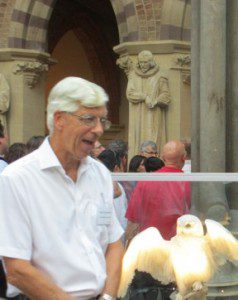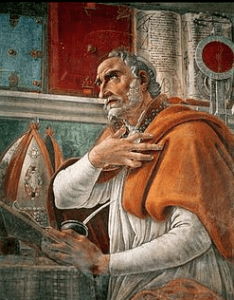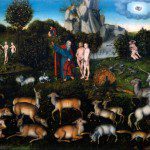 What does the word “evolution” actually mean? Does it mean a godless philosophy (for some, yes) or progress socially in the world (for some, yes). What does it mean in the scientific community?
What does the word “evolution” actually mean? Does it mean a godless philosophy (for some, yes) or progress socially in the world (for some, yes). What does it mean in the scientific community?
Denis Alexander, in Creation or Evolution: Do We Have to Choose?, answers this question in a lengthy, informed (and challenging for me) chapter that I sketch around three terms (age, genes, genomes). But this first:
Christians often criticise atheist scientists for their poor grasp of theology, with some justification, but sometimes the boot is on the other foot, and Christians make embarrassing declarations in public that reveal their inadequate grasp of biology and geology (59).
Evolution is a restricted theory: “The purpose of Darwinian theory is to explain the biological diversity that we see all around us on our planet” (59). He continues on p. 60: “The purpose of biological evolutionary theory is to explain where this teeming mass of life comes from and to work out how different living things are connected with each other.”
All of this, of course, is connected to the age of the universe. Here are his/science’s basic conclusions:
The best current estimate for the age of the material that forms the earth is 4,566 million years. The universe is three times older, at 13,700 million years (61).
And how do we know this?
Whether it is radioactive decay, cyclical changes in the earths orbit, flipping of the magnetic field, or the more prosaic counting of ice layers or tree rings, all of these various dating methods combine to form a powerful set of tools for establishing the extremely long periods of time required for evolution to occur. As we shall see later on, changes that occur in genetic material also provide a useful ‘internal clock’ for estimating age (67).
Involved in the same discussion are genes.
Genes are encoded by a chemical railed DNA. All the information for our inheritance, from our blue eyes to our knobbly knees, is encoded in our DNA. This consists of two strands of chemical ‘letters’ of the genetic alphabet, called nucleotides, which are wound round each other like intertwined coiled springs – the famous double helix. Each nucleotide on one strand pairs exactly with its opposite number on the other strand (known as ‘base-pairs’), that when a cell divides each DNA molecule makes copies of itself by unzipping’ the two strands, each of which then replicates itself to make two ‘daughter’ DNA molecules (67).
After looking at RNA, he sums this up with this: “The sum total of the DNA nucleotide sequence in a given organism is known as its ‘genome‘, so the term ‘genomics’ refers to the sequencing and ensuing comparisons of the genomes from various organisms” (70). He says that by 2020 more than a million humans will know their genome sequence. Organisms across the map have been mapped and “One of those surprises is already with us: the great variety in the size of genomes, which seems to bear no relationship to the complexity of the organism involved. Common-sense predictions might dictate that the more complex a living organism becomes, the bigger and more complex become its genome and the number of genes required to encode all that complexity. But common sense in this case is quite wrong” (72).
But now to evolution:
The theory of evolution consists of two ‘big ideas’ joined together and we need to understand both to make sense of the overall process.
First, there is the generation of diversity in the genome, for example by mutations of various kinds which occasionally make a difference to the ability of the resulting organism to survive and reproduce.
Second, there is the ensuing process of natural selection, whereby genomes generating organisms with slightly better survival and more offspring tend to be the ones passed on to succeeding generations. The reverse is also true: genomes generating organisms with slightly or significantly worse survival and fewer offspring are less likely to be passed on.
Therefore evolution is a two-step process: a device to generate diversity followed by a method for testing that diversity by natural selection(88).
Notice the absence of the term “random” that is so often bandied about by critics (we’ll hear more about “chance” at pp. 156-158).
In other words: (1) genes mutate, (2) individuals are selected, and (3) populations evolve (102).
Here is one of the best perspectives I’ve read on how it all happened (pp. 105-106):
One useful way to envisage history as viewed through the lens of evolution is to imagine the whole 4.6 billion year history of the earth as being crammed into a single day.
If we had a bird’s-eye view of the whole day, what would we see the Creator do, starting our 24-hour clock at zero and imagining that midnight is the present moment in time? Simple forms of life would already be appearing by 2.40 a.m. with single-celled organisms (prokaryotes) flourishing by around 5.20 a.m. The great oceans of the world start to change colour as cyanobacteria (blue-green algae) spread cross the planet. At the same time the genetic code becomes established that will dominate the generation of biological diversity for the remainder of the day.
After this early-morning start, there would then be quite a long wait until single-celled organisms containing nuclei (eukaryotes) become visible around lunchtime. A further seven hours pass before multicellular organisms (living things with more than one cell) start appearing in the sea by 8.15 p.m. About half an hour later the planet changes colour as cyanobacteria and green algae invade the land.
From then on the biological pace picks up and there is a busy evening of observation ahead. The Cambrian explosion starts at 9.10 p.m. and in an amazing three minutes an immense diversity of phyla appear, each with a distinctive body plan, with many of the anatomical features introduced continuing in many of the phyla right up to midnight. Twenty minutes later plants start appearing on land for the first time, followed very soon afterwards by the earliest land animals. At 9.58 p.m. this is followed by the mass extinctions of the Devonian period.
At 10.11 p.m. reptiles start roaming the land, followed half an hour later by the mass extinctions that mark the end of the Palaeozoic period.
By 10.50 p.m. the earliest mammals and dinosaurs are appearing, but five minutes later there is further mass extinction at the start of the Jurassic period.
By 11.15 p.m. archaeopteryx are flapping around and within minutes the sky begins to fill with birds. Another mass extinction occurs at 11.39 p.m. in which the dinosaurs are wiped out.
Just two minutes before midnight hominids start to appear, and a mere three seconds before midnight anatomically modern humans make their entry onto the scene, the whole of recorded human history until now being compressed into less than one-fifth of the second before midnight, the mere blink of a human eyelid.











